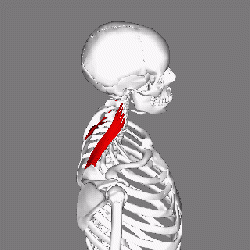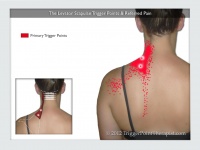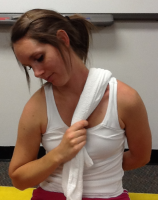Levator Scapulae Syndrome: Difference between revisions
Rachael Lowe (talk | contribs) No edit summary |
Rachael Lowe (talk | contribs) No edit summary |
||
| Line 31: | Line 31: | ||
*Increased muscle tone and trigger points. | *Increased muscle tone and trigger points. | ||
[[Image:Levator scapula trigger points referred pain.jpg|right|200px]] | [[Image:Levator scapula trigger points referred pain.jpg|right|200px]] | ||
=== Trigger points === | === Trigger points === | ||
| Line 37: | Line 37: | ||
The Levator Scapulae can present with two trigger points located in the lower half of the muscle. The lower trigger point lies just above the superior angle of the scapula and upper trigger point lies 1-3 inches above the lower trigger point. Both trigger points lie deep to the upper trapezius muscle. Both trigger points refer pain laterally to the shoulder and along the medial aspect of the shoulder blade. | The Levator Scapulae can present with two trigger points located in the lower half of the muscle. The lower trigger point lies just above the superior angle of the scapula and upper trigger point lies 1-3 inches above the lower trigger point. Both trigger points lie deep to the upper trapezius muscle. Both trigger points refer pain laterally to the shoulder and along the medial aspect of the shoulder blade. | ||
== Examination == | == Examination == | ||
With this presentation of pain and trigger points in the region of the levator scapulae it is important to complete a full [[Cervical Examination|assessment of the cervical spine]] as pain in this region is often referred from the cervical spine. The presenting pain is likely to be reproduced on active and passive range of movement testing of the cervical spine especially flexion and side flexion to the contralateral side. The muscle is also likely to be tender on palpation and may present with increased tone, especially in the region of the trigger points. | |||
You must also rule out the thoracic spine and shoulder. The phenomenon of levator scapulae pain of cervical origin being reproduced on shoulder movement has long been clinically recognised<ref name="Behrsin">Behrsin JF and Maguire K. Levator Scapulae Action during Shoulder Movement: A Possible Mechanism for Shoulder Pain of Cervical Origin. Australian Journal of Physiotherapy, 1986, 32(2):101–106</ref>.<br> | |||
== Treatment == | |||
Primary treatment with be aimed at the dysfunction that you hypothesise to be causing the levator scapulae dysfunction i.e. the cervical spine. | |||
[[Image:Levator stretch.png|right|200x200px]]<span style="font-size: 13.28px; line-height: 19.92px;">It is also important that biomechanical problems that may be contributing to the condition, such as neck or shoulder muscles imbalances, postural problems, or thoracic mobility are identified and corrected as these are usually the causes of increased demands on the levator scapulae. </span>It is likely that you will provide postural advice to ease the demand on the levator scapulae as well as stretching exercises to relieve tension. <span style="line-height: 1.5em; font-size: 13.28px; font-weight: normal;">Levator scapulae can respond well[[Active_Release_Techniques| Active Release Techniques]] (ART).</span> | |||
It is also important that biomechanical problems that may be contributing to the condition, such as neck or shoulder muscles imbalances, postural problems, or | |||
== Recent Related Research (from [http://www.ncbi.nlm.nih.gov/pubmed/ Pubmed]) == | == Recent Related Research (from [http://www.ncbi.nlm.nih.gov/pubmed/ Pubmed]) == | ||
<div class="researchbox">
<rss>http://www.ncbi.nlm.nih.gov/entrez/eutils/erss.cgi?rss_guid= | <div class="researchbox">
<rss>http://www.ncbi.nlm.nih.gov/entrez/eutils/erss.cgi?rss_guid=1hgsEQZ6hYloDg_C4QJ56FzQyJXZ7_MBllsbyPMeTPAPe-69Ko|charset=UTF8|short|max=10</rss>
</div> | ||
= References = | = References = | ||
Revision as of 16:35, 18 January 2016
Top Contributors - Andeela Hafeez, Rachael Lowe, Tony Lowe, Kim Jackson, Alexander De Bock, WikiSysop, Eugenie Lamprecht, Shwe Shwe U Marma, 127.0.0.1, Kishan Muthukuda, Evan Thomas and Robin Meynendonckx
Introduction [edit | edit source]
Levator Scapulae Syndrome is an historical name for "pain over the upper medial angle of the scapula"[1] that is still used in clinical practice in some places around the world. This terminology (and use of the word syndrome) describes is a set of signs and symptoms that often present together without identifying the cause of the pain and dysfunction i.e chronic fatigue syndrome, irritable bowel syndrome. These days we prefer to use our clinical reasoning skills to identify possible causative factors that we can address during treatment.
Clinically Relevant Anatomy[edit | edit source]
The levator scapulae muscle extends from C1-4 to the medial aspect of the scapula, between the superior angle and the root of the spine. It's function is to assist with various neck, arm and shoulder movements such as shoulder elevation and cervical side flexion.
Description[edit | edit source]
Often this muscle can become tense and painful leading to reduced motion in the area. The dominant shoulder is most commonly involved (82%) and pain radiated to the neck and shoulder, but rarely to the arm[1].
Causes[edit | edit source]
- Cervical spine dysfunction.
- Altered shoulder biomechanics or poor posture.
- Repetitive arm motions such as in swimming, throwing, or racquet sports.
- Carrying bags with straps over the shoulder.
- In anxiety many people who experience the effects of these trigger points also complain of a shortness of breathe like that associated with panic attacks.
Sign and Symptoms[edit | edit source]
- Neck pain, which may extend to the head causing a headache.
- Pain and restricted range of movement, especially reduced cervical flexion and side flexion to the contralateral side.
- Deep, achy pain and/or tightness on the upper back along the top of the shoulder blade or neck.
- Increased muscle tone and trigger points.
Trigger points[edit | edit source]
The Levator Scapulae can present with two trigger points located in the lower half of the muscle. The lower trigger point lies just above the superior angle of the scapula and upper trigger point lies 1-3 inches above the lower trigger point. Both trigger points lie deep to the upper trapezius muscle. Both trigger points refer pain laterally to the shoulder and along the medial aspect of the shoulder blade.
Examination[edit | edit source]
With this presentation of pain and trigger points in the region of the levator scapulae it is important to complete a full assessment of the cervical spine as pain in this region is often referred from the cervical spine. The presenting pain is likely to be reproduced on active and passive range of movement testing of the cervical spine especially flexion and side flexion to the contralateral side. The muscle is also likely to be tender on palpation and may present with increased tone, especially in the region of the trigger points.
You must also rule out the thoracic spine and shoulder. The phenomenon of levator scapulae pain of cervical origin being reproduced on shoulder movement has long been clinically recognised[2].
Treatment[edit | edit source]
Primary treatment with be aimed at the dysfunction that you hypothesise to be causing the levator scapulae dysfunction i.e. the cervical spine.
It is also important that biomechanical problems that may be contributing to the condition, such as neck or shoulder muscles imbalances, postural problems, or thoracic mobility are identified and corrected as these are usually the causes of increased demands on the levator scapulae. It is likely that you will provide postural advice to ease the demand on the levator scapulae as well as stretching exercises to relieve tension. Levator scapulae can respond well Active Release Techniques (ART).
Recent Related Research (from Pubmed)[edit | edit source]
References[edit | edit source]
- ↑ 1.0 1.1 Menachem A1, Kaplan O, Dekel S. Levator scapulae syndrome: an anatomic-clinical study. Bull Hosp Jt Dis. 1993 Spring;53(1):21-4.
- ↑ Behrsin JF and Maguire K. Levator Scapulae Action during Shoulder Movement: A Possible Mechanism for Shoulder Pain of Cervical Origin. Australian Journal of Physiotherapy, 1986, 32(2):101–106









